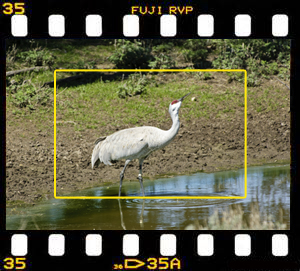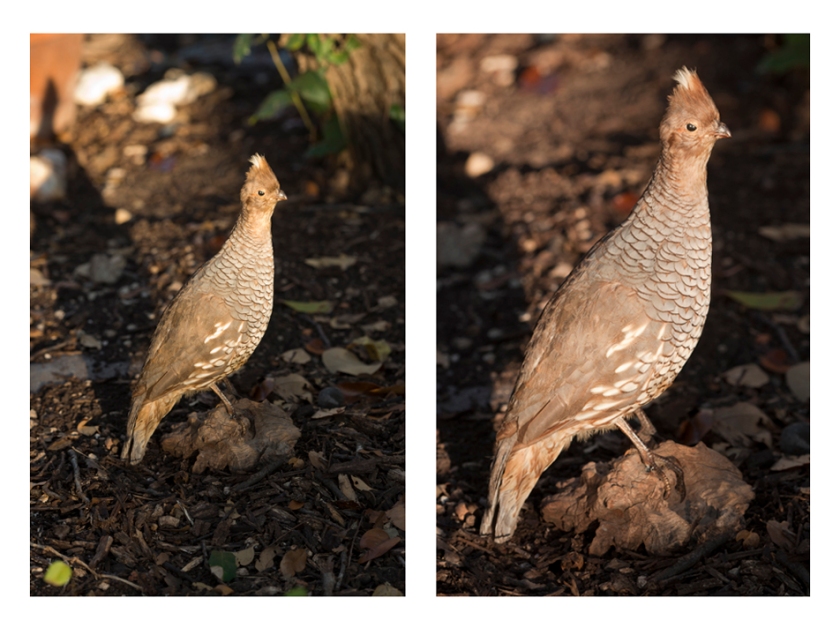Why crop sensor cameras do not produce greater subject magnification than their full-frame brothers.
I am disturbed by a lot of talk over the last few years stating that cameras with “crop sensors” produce larger in-camera subject size to cameras with full frame sensors. This thinking is both incorrect and continues to mislead the photography world. I feel this misleading language comes from two camps: One, the marketing folks who try to tell us that with a 1.6 crop sensor our 200mm lens is now a 320mm lens. And two, the wildlife photographers who want large in-camera images and who use a crop sensor camera believing the crop sensor somehow produces greater subject magnification.
Let me provide a couple of examples of that talk:
“For nature, wildlife and sports enthusiasts, it might make more sense to stick with a smaller sensor. You can take advantage of the crop factor to get maximum detail at long distances.” http://digital-photography-school.com/full-frame-sensor-vs-crop-sensor-which-is-right-for-you/
“…the Mark IV has the 1.3 crop factor and a higher megapixel count than the D3s, which are nice for telephoto work.” http://www.deepgreenphotography.com/the-gear/
“Focal length measurements on lenses are based on the 35mm standard. If you are using a crop frame camera the sensor is cropping out the edges of the frame, which is effectively increasing the focal length. The amount of difference in the field of view or focal length with a crop sensor is measured by its “Multiplier.” And,
“…while a crop sensor DSLR doesn’t provide the same level of image quality as a full frame DSLR, it does [offers] sic. major advantages when it comes to cost. It can also be very effective for telephoto photography for the extra reach gained from the crop sensor multiplier. For example, this can be very useful when shooting sports, wildlife, and other types of photojournalism…” both from: http://www.slrlounge.com/school/cropped-sensor-vs-full-frame-sensor-tips-in-2/
First let me state two facts: One, images from crop sensor cameras are not inherently of lower quality than those of full-frame cameras and, two, crop sensor cameras produce exactly the same in-camera image magnification as do their larger full-frame brothers.
Before I take this discussion of why these facts are true, let’s understand some things about cameras and their sensors.
First, a full-frame sensor gets its name from the fact that is physical measurements are, in round numbers, 24 x 36 mm. That’s the same size of our old standby, the full-frame 35mm film negative or transparency.
Second, I truly believe that the term, “crop sensor” is a misleading term. It is simply a sensor that is smaller than the full frame cousin. And there are now several sizes of “crop sensors”. They range from the APS-C (15.7 x 23.6 mm), the APS-H (19 x 28.7 mm), four thirds systems (13 x 17.3 mm), and even smaller. So there is really no “Standard” when it comes to identifying a sensor size.
Now let’s talk about the lens for a moment, the image forming device that projects our picture on to the sensor. Lenses have several characteristics. They affect:
- Image size. This is governed by the focal length. Longer focal lengths produce larger subjectdetail on the sensor at any given distance,
- Angle of view. This is the area of coverage in front of the lens that the lens may capture and project on to the sensor. It too is governed by focal length. Shorter focal lengths produce a wider angle of view that longer focal length telephotos for example. And finally,
- Perspective. This is a relationship of components within the image to others within the same image. Focal length affects perspective, but only when the lens-to-subject distance is changed.
Let’s look at the image above to understand the physical relationship. The large frame is that of standard 35 mm film and also that of a full frame digital sensor. The yellow outline represents the area and magnification of an APS-C sensor, similar to that of a Nikon D2X or D7100 series camera body. The image was taken with a Nikkor 80-200 mm F 2.8 zoom lens.
Lenses have physical characteristics in addition to the optical characteristics above. One that is most important here is lens flange-to-sensor distance. This is the physical distance from the rear mounting flange of the lens to the sensor. That distance is specific to allow the lens to be focused at infinity. This distance is somewhat different between manufacturers, but it is standard within a manufacturer family so that all lenses will work properly.
In order for a lens of any particular focal length to produce larger image details on the sensor, the lens must be moved farther from the sensor or closer to the subject. Since the flange-to-sensor distance must be the same for cameras of a particular brand, any given lens (of that brand) will produce an image of the same magnification at the sensor regardless of the sensor dimension. What changes is the area of the projected image, not its magnification.
So let’s look at how this works.
The set-up
A standard, single focal length 200mm prime telephoto lens is mounted on a tripod. A subject is placed at a constant, pre-measured distance from the lens for all images. And two camera bodies, Nikon D90 with its APS-C sensor and Nikon D800 with its full frame sensor, were used.
The Process
Two photos of a mounted scaled quail are made from the same spot. Nothing changes but the camera bodies. Both images are processed in Photoshop in the same manner. A new composite file was made using both images together. Each image was reproduced at the same magnification for comparison. The APS-C image is produced at a six times multiple of its actual size of 15.7 x 23.6 mm, and the full frame image is printed at the same six times multiple of its actual size of 24 x 36 mm.
The Result.
One can clearly see the subject is the same magnification on both sensors and the reproduction sizes of the bird are the same for both sensors. The full frame sensor on the left captures significant additional area than the smaller sensor. This is the source of the term “Crop Sensor”.
Left: Full frame sensor, Nikon D800. Right: Nikon D90 APS-C sensor. Initial enlargement (left) = 6 times sensor length 36 mm x 6= 216 mm. Initial enlargement (right) = 6 times sensor length 23.6 mm x 6= 141.6 mm.
The Misconception
When both images are reproduced at the same dimensions, the APS-C subject is reproduced at a larger size. This is only because the image is blown up to be the same reproduction size. This is why some people think there is actual in-camera magnification increase.
When viewed in the camera through the viewfinder or in live-view the smaller sensor frame is filled with the subject at a given distance than the full frame sensor. Therefore, the APS-C camera appears to produce a larger image. This is simply because the frame is filled faster with any given focal length and subject distance. What actually happens here is that the APS-C (crop sensor) image is blown up to match the outer dimensions of the full frame image.
Left, Nikon D800 full frame sensor. Right, Nikon D90 APS-C sensor.
Image quality
Image quality is not entirely based upon image size at the sensor, but is based upon in-camera processing technology, pixel size and pixel density. Many “crop sensor” cameras have better sensors and processing engines than full frame cameras. But that’s another story. (Maybe later.)
Copyright © 2014 Brian K Loflin . All rights reserved.





Good read. I was looking on amazon today when someone posted the question, “what are the differences between full frame and aps-c”, and the replies were so far off base. Anything from, “aps-c has lower quality image” to “aps-c has better magnification.” Some answers were good, but most were jsut straight up ignorant or bad advice. This article covers a lot of what I want to say in a reply, in hopes to get some good info out there. But, I’ll likely be ignored, or flamed. Whatever.
Forgot to ask the question I had. So, based on what you are saying here, would you say that not only do you not gain any zoom on a crop sensor, but really, you lose it? I have this theory, that, to fit everything into the same frame you have to stand further away from your subject, thus increasing the distance light has to travel to your sensor, inadvertently losing zoom. You don’t gain zoom, you lose field of view. To recover that lost FOV, you have to move away from your subject, which is not really any different than zooming out. Just a thought.
Kevin,
Whether or not the lens in question is a zoom or fixed focal length lens in not relative.
If you wish to cover the same FOV with a crop sensor camera as with a full frame camera, you must move back with a crop sensor camera.
Remember that lenses may control three things: Field of View, Subject size in the frame and perspective.
The difference between moving back from the subject and zooming is that to move back you decrease subject size in the frame, increase FOV but also change the perspective as well.
Thanks for the article Brian. I recently purchased a Canon R5 (45 MP full frame) to complement my Canon M6 mk II (32 MP APS-C). Since getting the R5 (with nearly 50% more MP over the M6) I have hardly touched the M6, but the other day I was thinking that for distant subjects the M6 might capture more detail, not because the image is magnified on the sensor (as you correctly point out) but rather because for an image captured with a given lens at a given distance, the number of pixels capturing the image will be greater with the M6 than with the R5. (You don’t seem to mention this in your article.)
For example, if a subject fills the M6 sensor, it will be captured as a 32 MP image. But the same subject (with the same lens at the same distance) captured by the R5 will be a 17 MP image (only about half the M6’s!) after cropping the R5’s image to the same frame as the M6.
So ignoring the many advantages of the R5 (better dynamic range, better high ISO performance, better auto focusing, and so on) I do actually agree with this quote from Digital Photography School (under some circumstances) that you mentioned in your article: “You can take advantage of the crop factor to get maximum detail at long distances.”
David,
Your expectations are correct. However, I may note that the R5 pixel count using the APS-C crop is almost equal to the M6mkII.
Using the short dimensions of the frame in mm and comparing the two you get:
24mm/18mm (round numbers) X 45MP = 33.7 MP. So the number of pixels are about the same count.
So, In my opinion, I don’t believe that you have an advantage.
What is not mentioned is the size of the pixels. Larger pixels tend to produce more detail. I do not know about those two cameras.
Doing the math, I think the R5 might have larger pixels.
The only way to know for certain is to do a side by side comparison of the two.